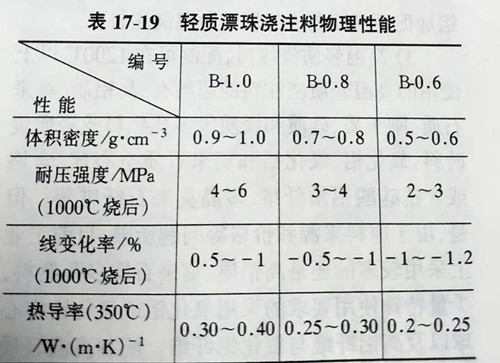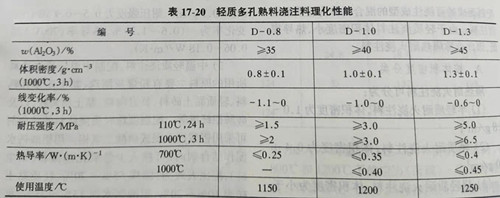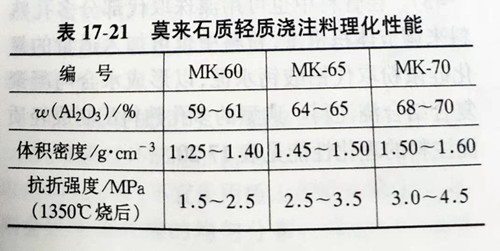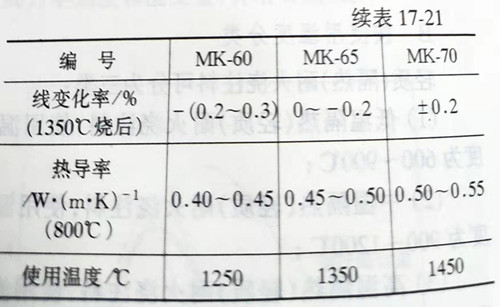Light Weight Refractory Castable
The castable mixture made of light refractory aggregate with powder binder and admixture is called light refractory castable. As a result of light castable volume density is small, thermal conductivity is low, so also called heat insulation refractory castable.
A by volume density
Heat insulating refractory castable can be divided into:
(1) semi-lightweight refractory castable with a volume density of 1.0~1.8g/cm3;
(2) lightweight refractory castable with a volume density of 0.4~1.0g/cm3;
(3) ultra-lightweight refractory castable with a volume density less than 0.4g/cm3.
B. Classification by operating temperature
Lightweight (thermal) refractory castables can be divided into three categories:
(1) low temperature heat insulation (light weight) refractory castable, service temperature is 600~900℃;
(2) medium temperature thermal insulation (light weight) refractory castable, using temperature of 900~1200℃;
(3) high temperature heat insulation (light weight) refractory castable, service temperature is 1200℃ >.
1) low-temperature light castable, the main raw materials used to prepare low-temperature light refractory castable are: expanded vermiculite, expanded perlite, diatomite and low-temperature ceramsite, etc. The binders available are ordinary Portland cement, aluminate cement and water glass. Compound expanded vermiculite castable, expanded vermiculite granules is usually 1 ~ 8 mm, expanded vermiculite aggregate and cement, Portland cement or aluminate cement quality than can be different according to request of bulk density and compressive strength to adjust, general proportion for the (35 ~ 45) : (55-65). The bulk density is reduced with the increase of content of expanded vermiculite, at the same time strength and thermal conductivity is also reduced. Expanded vermiculite can be used to prepare lightweight castable with a volume density of 0.4~0.6g/cm3 and a thermal conductivity of 0.08~0.15W/ (m·K) after drying.
The binder used in the preparation of the expanded perlite castable is similar to the expanded vermiculite castable, and phosphate can also be used as the binder. When ordinary calcium aluminate cement is used as binder, the ratio of expanded perlite (grain size 1~8mm) to the mass of cement is (35~50) :(50~65). In this proportion range, the physical properties of expanded perlite castable after firing at 900℃ are 0.3~0.7g/cm3, the compressive strength is 0.5~ 0.9mpa, the linear change rate is - (0.6~1.2) %, and the thermal conductivity (700℃) is 0.06~ 0.18w/(m·K).
2) medium temperature light castable, the main raw materials used in preparation of medium temperature light castable are fly ash drift beads, clay porous clinker, light clay brick, shale ceramsite, clay ceramsite, and aluminum silicate fiber, etc. Calcium aluminate cement or aluminum dihydrogen phosphate can be used as a binder for preparing light castable of drift-beads. When using calcium aluminate cement as binder, a small amount of silica powder (fume silica) can be added, the ratio is roughly: drift-bead 55%~70%, light clay brick 10%~20%, calcium aluminate cement 15%~25%, silica powder 3%~5% and trace additives. The volume density, compressive strength and thermal conductivity of drift-bead light castable decreased with the increase of drift-bead content in the castable. Table 17-19 shows the physical properties of drift-bead lightweight castables of different volume densities.

When preparing lightweight castable with clay porous clinker, the particle size composition of porous clinker is generally 10~ 5 mm, 40%~50%. 5~ 2.5mm, 25%~ 35%,2.5~ 1.0mm,20% ~ 30%. The matrix (powder) is composed of calcium aluminate cement and clay clinker powder. The amount of calcium aluminate cement is adjusted according to the requirement of compressive strength. The higher the requirement of compressive strength, the more cement is added. The ratio of aggregate to powder is (55~ 65):(35~45). The volume density can also be adjusted by replacing part of the porous clinker with drifter beads in the aggregate, and the calcium aluminate cement can be replaced by silica powder in the powder to form the composite composite castable of hydration and condensation. The physicochemical properties of the lightweight castable prepared from typical porous clinker are shown in table 17-20.

In addition to drifting-bead castables and porous clinker castables, there are also ceramsite (shale ceramsite, clay ceramsite) castables and lightweight castables compounded from several medium-temperature lightweight aggregate materials. In addition, aluminum silicate staple fiber with clay clinker powder, calcium aluminate cement or aluminum dihydrogen phosphate with hardening accelerator can also be used to make super lightweight medium temperature castable.
3) high temperature lightweight castable, the preparation of high temperature lightweight castable can be used at 1200℃ above the raw materials are: high aluminum, mullite, jade, silicon and magnesium porous clinker or lightweight waste brick, alumina, zirconia and mullite hollow ball, containing chromium or zirconium silicate aluminum fiber, polycrystalline mullite fiber. However, due to the source of raw materials and price problems, the current industrial use of high aluminum, mullite porous clinker, a small number of special requirements for the use of alumina or zirconia hollow balls and high aluminum fiber and alumina fiber. The binder for high temperature and light castable is pure calcium aluminate cement, aluminum dihydrogen phosphate, aluminum sulfate and silica sol.
The physical and chemical properties of mullite light castable prepared with 65%~72% Al2O3 content and 1.00~1.25 g/cm3 volume density of mullite porous clinker as aggregate, pure calcium aluminate cement as binder, and a small amount of silica powder are shown in table 17-21. This castable can be directly used as an atmosphere furnace lining for use at 1350℃.


Aluminum oxide hollow balls with A2O3 content greater than 98% and natural accumulation density of 500~ 800g/L were used as aggregate, and calcium aluminate cement and reactive alumina were used as powder. After drying at 110℃ for 24 h, the volume density was 1.3 ~ 1.6 g/cm3; Compressive strength 3~ 8MPa; Volume density after burning at 1550℃ : 1.35~1.65g/cm3; Compressive strength 4~ 12 MPa, true porosity 55% ~ 65%; Thermal conductivity (thermal surface temperature 1100℃)0.9~1.1 W/(m·K). This castable can be directly used as working linings for high temperature (> 1500℃) atmosphere furnaces.
Lightweight refractory castable is widely used in the lining of furnaces, thermal equipment, flue and smoke Windows in metallurgy, machinery, petrochemical, electric power and building materials industries. But now with the improvement of lightweight refractory castable material and the progress of preparation technology, there are also many occasions directly used as the working lining of atmosphere furnace. Generally low temperature, medium temperature type light castable mainly for thermal insulation lining, not directly in contact with the flame. A large part of the high temperature lightweight castable is directly used as the working lining that does not contact with the melt or solid medium in the furnace. In particular, it can be used as the working lining of various heating furnaces and heat treatment furnaces, which can greatly save energy consumption.

